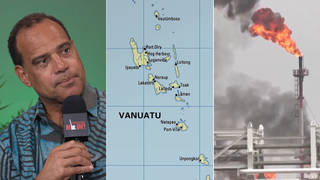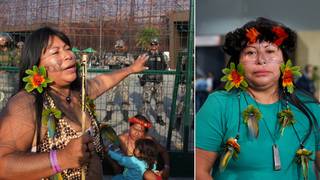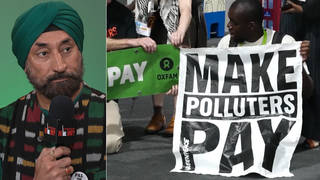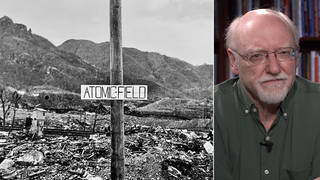
Topics
Defying US occupation forces, George Weller was the first reporter into Nagasaki after the US dropped the atomic bomb. His 25,000-word report did not get past the US military censors. Now dead, we speak with Weller’s son who has just discovered the carbon copy of the long-suppressed article. [includes rush transcript]
George Weller was one of the most intrepid foreign reporters of the twentieth century. Weller worked for the Chicago Daily News and was a Pulitzer Prize-winning journalist. He was the first reporter to enter Nagasaki, defying General MacArthur’s ban on the press in southern Japan. Weller hired a row boat to get himself there and wrote a 25,000-word report on the horrors that he encountered. When he submitted his story to the military censors, MacArthur personally ordered that the story be killed and the manuscript was never returned. Weller later summarized his experience with the government censors, saying, “They won.” Last month, Weller’s son Anthony discovered a copy of the suppressed dispatches among his late father’s papers — George Weller died in 2002 — and unable to sell it to an American publisher, sold the report to Mainichi Shimbun, a large Japanese newspaper. Now, on the sixtieth anniversary of the atomic bombings, Weller’s account can finally be read.
- Anthony Weller, son of journalist George Weller
Related links:
- Anthony Weller’s article published in the Mainichi Daily News.
- Editor and Publisher: A Great Nuclear-Age Mystery Solved
Transcript
JUAN GONZALEZ: We turn now to the story of George Weller, who was one of the most intrepid foreign reporters of the 20th century. Weller worked for the Chicago Daily News and was a Pulitzer Prize-winning journalist there. He was the first reporter to enter Nagasaki, defying General MacArthur’s ban on the press in southern Japan. Weller hired a rowboat to get himself there and wrote a 25,000-word report on the horrors that he encountered. When he submitted his story to the military censors, however, MacArthur personally ordered that the story be killed, and the manuscript was never returned. Weller later summarized his experience with the government censors saying, quote, “They won.”
AMY GOODMAN: Last month, Weller’s son, Anthony, discovered a copy of the suppressed dispatches among his late father’s papers. George Weller died in 2002. And unable to sell it to an American publisher, he sold the report to Mainichi Shimbun, a large Japanese newspaper. Now on the 60th anniversary of the atomic bombings, Weller’s account can finally be read. We are joined on the phone from Massachusetts by George Weller’s son, Anthony Weller, also a writer. Welcome to Democracy Now!
ANTHONY WELLER: Thank you very much for having me.
AMY GOODMAN: It’s good to have you with us. Talk about finding these papers.
ANTHONY WELLER: Well, you know, my father had talked about this situation ever since I can remember. He was deeply frustrated by it, frustrated by the fact that these dispatches, written over a period of three weeks, had been all censored, and also, of course, frustrated by the fact that his own copies, which he believed to be the only copies, and which I think are the only copies, somehow went astray amid the tumult of a globetrotting war correspondent’s life. And when — I should correct you very slightly, which is that what was published in Japan was really a very small portion of the whole, and indeed Crown is going to be publishing a book containing the entire dispatches this coming year in the United States, and they will be published overseas, as well, I believe. But you can imagine, I’m sure, the sense of relief and vindication I felt when, in going through a tumultuous room filled with his papers, I finally came across the missing Nagasaki dispatches in a mildewed crate at the bottom.
JUAN GONZALEZ: And what did he tell you years earlier about, one, his interaction both with the military on the censorship, as well as how his paper reacted, his own newspaper reacted, to the complete censorship of his stories?
ANTHONY WELLER: Well, the newspaper, of course, was furious, as was he, for the obvious reasons. They’d had this man who’d bucked MacArthur’s orders, snuck over the mainland in a rowboat, taken trains for two days, made his way up to Nagasaki, impersonated a US officer by saying he was Colonel Weller, rather than a war correspondent, and risked quite a bit to get the stories out. And then, of course, because he was under the aegis of MacArthur’s censors, there was no way that his newspaper could publish the articles. So there was tremendous frustration, which lasted all his life. And, of course, very rapidly the story became old news, because suddenly, you know, the United States public was getting what they were supposed to get about what the bomb sites were like, and my father had moved on to other theaters of war, and the decades went by and he never came across the stories. So, I think he would have and could have published them twenty years ago, thirty years ago, had he been able to find them, but he couldn’t.
AMY GOODMAN: Anthony Weller, your father wrote a devastating description of what took place in Nagasaki. Can you share some of the descriptions? We just began the show by talking about another reporter, William Laurence of The New York Times, who won a Pulitzer for his coverage, very much playing down the lethal effects of radiation, also turned out he was on the payroll of the U.S. government.
ANTHONY WELLER: Right.
AMY GOODMAN: Your father described it very graphically, the people who had survived and who had died.
ANTHONY WELLER: Well, I think the thing that astonished him the most — I mean, there were many things that he found astonishing. Remember, he went in there four weeks, almost to the minute, after the bomb was dropped, which was on the 6th of September in mid-morning, is when he arrived. And he was struck, obviously, by several things — by the physical appearance of the city, which was still smoldering here and there, by the surgical precision of the bomb itself. Later, he was to learn that, in fact, a great deal of damage had been done not just by the bomb, but by the fires that erupted, because people were cooking their midday meal when the bomb hit, and a number of wooden residences just caught fire, and the fire spread. So, in a way, it was kind of like a Dresden.
And as he went around the ruins of the city and rapidly began visiting all the hospital facilities that still existed, I know he was struck immediately, first by the absence of any American medical personnel there — four weeks later, there were still no doctors or nurses — and then, by the great precision and care with which the Japanese doctors had already catalogued the effects of the bomb on individual organs of the body.
And over the next few days, he was as astonished as the Japanese doctors were, of course, by what he referred to in his reports as “Disease X.” It was perhaps not so astonishing to see some of the scorches and burns that people had suffered, but to see people apparently unblemished at all by the bomb, who had seemingly survived intact, suddenly finding themselves feeling unwell and going to hospital, sitting there on their cots surrounded by doctors and relatives who could do nothing, and finding when he would go back the next day that they had just died, or that, let’s say a woman who had come through unscathed making dinner for her husband and having the misfortune to make a very small cut in her finger while peeling a lemon, would just keep bleeding, and bleed to death, because the platelets in her bloodstream had been so reduced that the blood couldn’t clot anymore.
So there were case after case like this, and, in a way, I think my father found them more poignant than the obvious destruction or the obvious burn victims, because here was a whole team of Japanese doctors, very able, very aware from long before the war had started about the potentials of radiation, absolutely baffled. And he had a wonderful phrase he used. He said the effects of the bomb uncured because — excuse me, the effects of “Disease X,” which is what they were calling it, uncured because it is untreated, and untreated because it is undiagnosed.
AMY GOODMAN: Anthony Weller, I want to thank you very much for being with us, son of George Weller, Pulitzer Prize-winning reporter, made it to Nagasaki, wrote a more than 25,000-word report. It didn’t clear the U.S. military censors. First reporter into Nagasaki. When we come back from our break, we’ll hear about the footage that a Japanese news team took that also was classified, kept secret for decades, and then finally, we’ll hear from a Hibakusha, from a Hiroshima survivor, a man who did survive, but talks about being one of the living dead.












Media Options